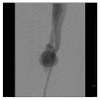A Case of Superficial Femoral Arteriovenous Fistula and Severe Venous Stasis Ulceration, Managed with an Iliac Extender Prosthesis
- PMID: 28808595
- PMCID: PMC5541807
- DOI: 10.1155/2017/9460958
A Case of Superficial Femoral Arteriovenous Fistula and Severe Venous Stasis Ulceration, Managed with an Iliac Extender Prosthesis
Abstract
Most femoral artery arteriovenous fistulas occur as a result of percutaneous interventions. However, arteriovenous fistulas can occur in the setting of trauma, with resultant consequences such as heart failure, steal syndrome, or venous insufficiency. Indications for endovascular repair in this setting are limited to patients who are at too high risk for anesthesia, have a hostile groin, or would not survive significant bleeding. We report the case of a traumatic femoral arteriovenous fistula, causing severe venous insufficiency and arteriomegaly, in a 58-year-old male, with history of traumatic gunshot wound complicated by popliteal DVT. Surgical options for arteriovenous fistula include open and endovascular repair but this patient's fistula was more suitable for endovascular repair for reasons that will be discussed.
Figures







Similar articles
-
Endovascular repair of posttraumatic multiple femoral-femoral and popliteal-popliteal arteriovenous fistula with Viabahn and excluder stent graft.Vojnosanit Pregl. 2011 Jul;68(7):616-20. doi: 10.2298/vsp1107616s. Vojnosanit Pregl. 2011. PMID: 21899185
-
Repair of a high-flow superficial femoral arteriovenous fistula using a bell-bottom iliac limb endoprosthesis.J Vasc Surg Cases Innov Tech. 2022 Jan 5;8(1):98-101. doi: 10.1016/j.jvscit.2021.11.010. eCollection 2022 Mar. J Vasc Surg Cases Innov Tech. 2022. PMID: 35146218 Free PMC article.
-
Novel Approach to a Giant External Iliac Vein Aneurysm Secondary to Posttraumatic Femoral Arteriovenous Fistula.Vasc Endovascular Surg. 2015 Jul-Aug;49(5-6):148-51. doi: 10.1177/1538574415602781. Epub 2015 Sep 2. Vasc Endovascular Surg. 2015. PMID: 26335991
-
A case of high-output heart failure caused by a femoral arteriovenous fistula after endovenous laser ablation treatment of the saphenous vein.Phlebology. 2015 May;30(4):290-2. doi: 10.1177/0268355514525149. Epub 2014 Feb 19. Phlebology. 2015. PMID: 24553135 Review.
-
Traumatic superior mesenteric arteriovenous fistula: report of a case and review of the literature.J Vasc Surg. 1987 Mar;5(3):486-91. J Vasc Surg. 1987. PMID: 3334681 Review.
Cited by
-
Management of dual traumatic arterial-venous fistula from a single shotgun injury: a case report and literature review.BMC Surg. 2020 Aug 5;20(1):177. doi: 10.1186/s12893-020-00833-5. BMC Surg. 2020. PMID: 32758209 Free PMC article. Review.
References
Publication types
LinkOut - more resources
Full Text Sources
Other Literature Sources

